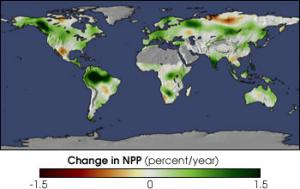Food securityCO2 fertilization is greening the Earth
A new, comprehensive study shows a significant greening of a quarter to one-half of the Earth’s vegetated lands. The greening represents an increase in leaves on plants and trees. Green leaves produce sugars using energy in the sunlight to mix carbon dioxide (CO2) drawn in from the air with water and nutrients pumped in from the ground.

Greening of the earth as a result of increased carbon dioxide levels // Source: nasa.gov
An international team of 32 authors from 24 institutions in eight countries has just published a study titled “Greening of the Earth and its Drivers” in the journal Nature Climate Change showing significant greening of a quarter to one-half of the Earth’s vegetated lands using data from the NASA-MODIS and NOAA-AVHRR satellite sensors of the past thirty-three years. The greening represents an increase in leaves on plants and trees. Green leaves produce sugars using energy in the sunlight to mix carbon dioxide (CO2) drawn in from the air with water and nutrients pumped in from the ground. These sugars are the source of food, fiber, and fuel for life on Earth. More sugars are produced when there is more CO2 in the air, and this is called CO2 fertilization.
“We were able to tie the greening largely to the fertilizing effect of rising atmospheric CO2 concentration by tasking several computer models to mimic plant growthobserved in the satellite data,” says co-author Prof. Ranga Myneni of the Department of Earth and Environment at Boston University, USA. Burning oil, gas, coal and wood for energy releases CO2 in to the air. The amount of CO2 in the air has been increasing since the industrial age and currently stands at a level not seen in at least half-a-million years. It is the chief culprit of climate change.
Boston U notes that about 85 percent of the Earth’s ice-free lands is covered by vegetation. The area of all green leaves on Earth is equal to, on average, 32 percent of the Earth’s total surface area - oceans, lands and permanent ice sheets combined. “The greening over the past 33 years reported in this study is equivalent to adding a green continent about two-times the size of mainland USA (18 million km2), and has the ability to fundamentally change the cycling of water and carbon in the climate system,” says lead author Dr. Zaichun Zhu, a researcher from Peking University, China, who did the first-half of this study as a Visiting Scholar in the Department of Earth and Environment at Boston University, USA, together with Prof. Myneni.
Every year, about one-half of the ten billion tons of carbon emitted in to the atmosphere from human activities remains temporarily stored, in about equal parts, in the oceans and plants. “While our study did not address the connection between greening and carbon storage in plants, other studies have reported an increasing carbon sink on land since the 1980s, which is entirely consistent with the idea of a greening Earth,” says coauthor Prof. Shilong Piao of the Chinese Academy of Sciences Center for Excellence in Tibetan Plateau Earth Science, Beijing, China.
The beneficial aspect of CO2 fertilization in promoting plant growth has been used by contrarians, notably Lord Ridley (hereditary peer in the U.K. House of Lords) and Mr. Rupert Murdoch (owner of several news outlets), to argue against cuts in carbon emissions to mitigate climate change, similar to those agreed at the 21st Conference of Parties (COP) meeting in Paris last year under the UN Framework on Climate Change (UNFCCC). “The fallacy of the contrarian argument is two-fold. First, the many negative aspects of climate change, namely global warming, rising sea levels, melting glaciers and sea ice, more severe tropical storms, etc. are not acknowledged. Second, studies have shown that plants acclimatize, or adjust, to rising CO2 concentration and the fertilization effect diminishes over time,” says co-author Dr. Philippe Ciais, Associate Director of the Laboratory of Climate and Environmental Sciences, Gif-suvYvette, France and Contributing Lead Author of the Carbon Chapter for the recent IPCC Assessment Report 5.
CO2 fertilization is only one, albeit a predominant, reason why the Earth is greening. The study also identified climate change, nitrogen fertilization and land management as other important reasons. “While the detection of greening is based on measurements, the attribution to various drivers is based on models, and these models have known deficiencies. Future works will undoubtedly question and refine our results,” says coauthor Dr. Josep Canadell of the CSIRO Oceans and Atmosphere Division in Canberra, Australia and leader of the Global Carbon Project.
— Read more in Zaichun Zhu et al., “Greening of the Earth and its drivers” Nature Climate Change (25 April 2016) (doi:10.1038/nclimate3004) (doi:10.1038/nclimate3004)
